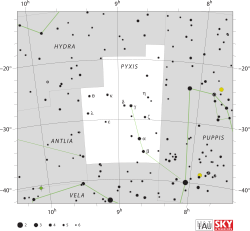Star in the constellation Pyxis
Zeta Pyxidis (ζ Pyxidis ) is a wide binary star system in the southern constellation of Pyxis . It is visible to the naked eye with a combined apparent visual magnitude of +4.88. Based upon an annual parallax shift of 13.35 mas as seen from Earth, it is located around 244 light years from the Sun.
The yellow-hued primary, component A, is an evolved G-type giant star with a stellar classification of G6 IIIb CN-0.5, where the suffix notation indicating it has anomalously weak lines of cyanogen . At the age of 1.88 billion years, is a red clump star that is generating energy through the fusion of helium at its core. The primary has nearly double the mass of the Sun and is radiating 69 times the Sun's luminosity from its photosphere at an effective temperature of 4,876 K.
The companion, component B, is a magnitude 9.59 star at an angular separation of 52.20 arc seconds along a position angle of 61°, as of 2010.
References
^ van Leeuwen, F. (2007), "Validation of the new Hipparcos reduction", Astronomy and Astrophysics , 474 (2): 653–664, arXiv :0708.1752 , Bibcode :2007A&A...474..653V , doi :10.1051/0004-6361:20078357 , S2CID 18759600 .
^ Cousins, A. W. J.; et al. (1966), "Photoelectric magnitudes and colours of southern stars, II", Royal Observatory Bulletins , 121 : 1, Bibcode :1966RGOB..121....1C .
^ Mason, B. D.; et al. (2014), "The Washington Visual Double Star Catalog", The Astronomical Journal , 122 (6): 3466, Bibcode :2001AJ....122.3466M , doi :10.1086/323920
^ Keenan, Philip C.; McNeil, Raymond C. (1989), "The Perkins catalog of revised MK types for the cooler stars", Astrophysical Journal Supplement Series , 71 : 245, Bibcode :1989ApJS...71..245K , doi :10.1086/191373 , S2CID 123149047 .
^ Luck, R. Earle (2015), "Abundances in the Local Region. I. G and K Giants", The Astronomical Journal , 150 (3): 88, arXiv :1507.01466 , Bibcode :2015AJ....150...88L , doi :10.1088/0004-6256/150/3/88 , S2CID 118505114 .
Anderson, E.; Francis, Ch. (2012), "XHIP: An extended hipparcos compilation", Astronomy Letters , 38 (5): 331, arXiv :1108.4971 , Bibcode :2012AstL...38..331A , doi :10.1134/S1063773712050015 , S2CID 119257644 .
^ Alves, S.; et al. (April 2015), "Determination of the spectroscopic stellar parameters for 257 field giant stars", Monthly Notices of the Royal Astronomical Society , 448 (3): 2749–2765, arXiv :1503.02556 , Bibcode :2015MNRAS.448.2749A , doi :10.1093/mnras/stv189 , S2CID 119217930 .
"zet Pyx" . SIMBAD Centre de données astronomiques de Strasbourg . Retrieved 2017-07-16.Eggleton, P. P.; Tokovinin, A. A. (September 2008), "A catalogue of multiplicity among bright stellar systems", Monthly Notices of the Royal Astronomical Society 389 (2): 869–879, arXiv :0806.2878 , Bibcode :2008MNRAS.389..869E , doi :10.1111/j.1365-2966.2008.13596.x , S2CID 14878976 .
Alves, David R. (August 2000), "K-Band Calibration of the Red Clump Luminosity", The Astrophysical Journal , 539 (2): 732–741, arXiv :astro-ph/0003329 , Bibcode :2000ApJ...539..732A , doi :10.1086/309278 , S2CID 16673121 .
Categories :
Text is available under the Creative Commons Attribution-ShareAlike License. Additional terms may apply.
**DISCLAIMER** We are not affiliated with Wikipedia, and Cloudflare.
The information presented on this site is for general informational purposes only and does not constitute medical advice.
You should always have a personal consultation with a healthcare professional before making changes to your diet, medication, or exercise routine.
AI helps with the correspondence in our chat.
We participate in an affiliate program. If you buy something through a link, we may earn a commission 💕
↑
